Inventor Quick Links
Texas A&M Innovation (TI) uses a comprehensive process to manage Intellectual Property (IP) from across The Texas A&M University System; including engaging with the creators of IP, forming IP protection strategies, conducting market research, and implementing commercialization plans. Every year many projects are successfully commercialized, with significant societal and financial impacts.
The process flowchart captures the steps that are typical for an innovation project to achieve commercialization success through either a license to an established company or a spinout new company, with timing expectations for some of the steps. Please note that the flowchart is not meant to create “gates” that must be passed through before subsequent steps can be initiated. For example, even though filing patents typically happens after the Deep Assess step, there will be examples where the Quick Assess step provides enough justification to file a patent, allowing a patent to be filed before the Deep Assess step is completed.
The following text supplements the process flowchart and provides more details. If you still have questions after reviewing the process flowchart and the following text, please contact Texas A&M Innovation at innovation@tamus.edu and a member of our team will reply to you shortly.

Following receipt of a new invention disclosure, TI responds to the IP creators within approximately 3 days to confirm receipt. A unique internal reference number will be produced, and a licensing manager will be assigned to manage the case. If the invention disclosure requires additional information, the creator(s) will be notified what additional information is required.
TI conducts a preliminary assessment of every new invention disclosure, usually within 3 weeks, to evaluate potential IP protection and market opportunity, and to provide an initial assessment of the disclosed technology’s commercial potential. During this step, a member of the TI licensing team will meet with the creator(s) to better understand the details of the disclosed technology. Export control review will also be completed during this step.
For technologies that TI identifies as not having sufficient commercialization potential and/or potential for IP protection, TI communicates to the creators the reasons for that conclusion, which could include suggestions for ways to address the commercialization shortcomings.
Successfully commercializing new technologies can be challenging, and it’s a reality of this kind of business that most new technologies are not successfully commercialized. If TI decides not to pursue commercialization and the creators would still like to pursue commercialization of their technology, even after discussions with TI explaining the commercialization challenges, TI will, upon request by the creator(s), consider transferring the rights to the technology to the creators so they may pursue commercialization on their own.
For technologies that are determined to have sufficient commercial potential and potential for IP protection through Quick Assess, TI conducts a more in-depth assessment to better characterize the market opportunity, competitive advantages of the technology, and positioning of the technology for commercialization. This deep assessment typically takes up to 3 months and may involve multiple meetings between the licensing team and the IP creators as they work together to formulate a commercialization plan.
To improve likelihood of commercialization, TI helps guide creators toward resources to de-risk and increase the value of the technology through proof-of-concept demonstrations using internal funding sources, such as the Translational Investment Fund and Advancing Discovery to Market fund, and identifying external funding opportunities that may exist. Sponsored research can also be impactful during this stage, both for providing development funding and as part of establishing collaborations with potential commercialization partners. At this stage, TI may also add value by working with the creators to file intellectual property protection.
TI forms a customized commercialization plan in partnership with the creators and other stakeholders to define the IP protection strategy for the technology, additional technology development needs and identification of resources that may be required, and pathway to market including whether the technology should be licensed to an established commercial entity or advanced through a new venture/startup.
In some cases, TI brings additional market-specific expertise into its commercialization work through advisory committees, which are consulted to inform a sound commercialization plan to improve likelihood of success for promising technologies.
There are many factors that influence the decision of Commercialization Pathway. Technologies that are likely to lead to a product are usually commercialized through a license to an established company. Technologies that are likely to lead to a platform of products, or that otherwise are challenging to commercialize through a license to an existing company, may be commercialized through a New Company (Newco).
License
TI will actively market the technology to potential licensees for inclusion as part of an exclusive or non-exclusive license agreement. TI will negotiate license terms with the licensee, and work with The Texas A&M University System Office of General Counsel to execute the license agreement.
NewCo
TI identifies opportunities for new venture creation and supports entrepreneurial activities for these companies. The TI New Ventures Team brings expertise to evaluate, advise, and engage in the operation of startups.
After completing agreements for a license or a NewCo, TI will continue to support the project by working with the commercialization partner and creators to identify ways Texas A&M can contribute to successfully commercialized products based on Texas A&M technologies.

